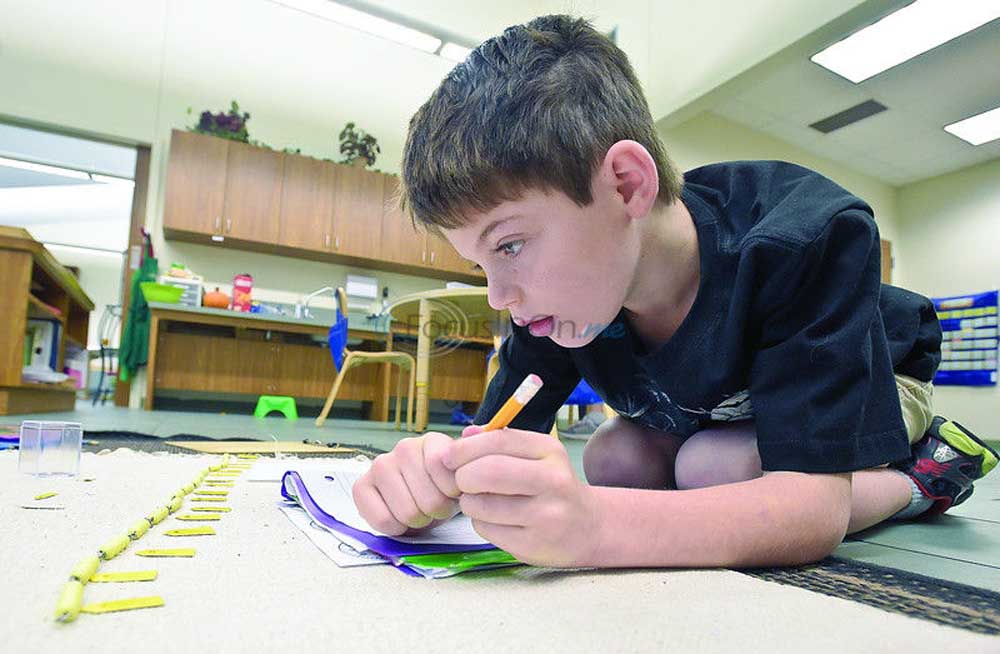Oak Hill Montessori offers hands-on approach to learning
Published 9:29 pm Monday, November 2, 2015

- Elementary student Jackson Willis, 7, uses strings of beads to visualize numbers as part of a math exercise on Friday at the Oak Hill Montessori School in Tyler. Giving students the opportunity to see concrete examples of more abstract concepts such as numbers aids in the educational process, Directoress Louise Dyer said. Andrew D. Brosig/Tyler Morning Telegraph
On any given day at Oak Hill Montessori School, students can be found working with strings of beads to learn addition, pouring milk and setting a dining table to learn practical life skills and rearranging letters of a wooden alphabet to learn to spell.
The activities are all part of the school’s tactile approach to teaching.
Opened in August 2008 on six acres at 6720 Oak Hill Boulevard, Oak Hill is not the same as a public school or any other private school in Tyler and operates year-round, including before and after school care. There are 146 students.
It is based on an educational philosophy and approach developed by Italian physician and educator Maria Montessori. She was the first woman to attend medical school, receiving her medical degree in 1896, when she began working with children.
The Montessori Method emphasizes a child’s educational, psychological, physical and social development with the pupil allowed to make choices and have constant freedom of movement within the classroom.
Seth Atkinson, 8, has been attending Oak Hill Montessori School seven years. “I like it because I’ve been going here for so long and I know the whole school. It’s fun,” he said. “I like math and science. I’m way ahead in math than anyone else in my grade. I just like adding and subtracting. I like science explosions. I like cultural arts because that’s when we learn about plants and animals and states and countries.”
The Montessori concept is honoring and respecting the child and the child’s abilities and gifts and then assisting the child in developing a love to learn, said Louise Dyer, Oak Hill Montessori School’s owner, head and director.
“The overall purpose of Montessori is for a child to love learning for their entire life,” she said. “It should not stop when you walk out the door, when you graduate from high school, when you graduate from college, but you continue to grow and develop intellectually as well as socially and do as much as we can for humanity.”
The school has no textbooks. “We learn from our hands first (in a tactile approach). Children are not abstract thinkers until the latter part of the third year of elementary school and then we begin doing research,” Mrs. Dyer said.
Students do research in a library in each classroom and on the Internet, finding answers to questions such as what is the longest river in the world.
The whole thing involves allowing children to unfold at their rate of development, Mrs. Dyer said.
“Whenever children unfold at their rate of development, they are going to love to learn. They are going to love to seek and find out and whenever you honor that child’s abilities and that child doesn’t think of education or school as horrible, they love to come to school,” Mrs. Dyer said.
Noah McBride, 8, who has been attending Oak Hill Montessori School three years, said, “I like it here because there’s lot of fun things. I like math. I’m already into times, minuses and pluses.”
The process of allowing children to “unfold at their own rate of development” means, for example, that a child can work as long as the child wants to on learning how to add until that has been accomplished, Mrs. Dyer said.
“It doesn’t say we are going to be on page 23 tomorrow. We say you work it until you understand it 100 percent, because that’s the foundation that something else is going to sit on top of.”
In the elementary program, if students make an 85 on spelling, teachers tell them to go back and study more until they get a 100. That is the practical approach in math, language, science, geography, history, Spanish, art, music and other subjects.
The school has three playgrounds for every age level and soccer and physical education. But organized sports are not for younger children because with the Montessori approach, it is felt they are not developmentally ready for them, so their activity is gross motor skill activity out on the playground, Mrs. Dyer said.
Oak Hill Montessori School started out serving children 18 months old through prekindergarten and then began adding a grade a year until it reached fifth grade this year. Plans are to add sixth grade next year and keep on adding grades through high school.
It is accredited by AdvancED, a world international organization.
“In Montessori, you follow the child and whatever the child is ready for the next step, you present that to the child. We don’t look at chronological age. Everything is developmental because God created us all differently,” Mrs. Dyer said.
Oak Hill Montessori School has three age levels in the same classroom. The reason is that Dr. Montessori’s research showed that with three age levels, children are nurturing and helping and take care of each other. “You want that peaceful environment,” Mrs. Dyer said.
Hailey Elan, 8, an Oak Hill pupil for five years, said, “I like going here. We can ask for friends to help us on our work. My favorite subjects are math and science. I like adding and subtraction and learning a lot.”
Describing how children are taught, Mrs. Dyer said, “In Montessori, everything is presented concretely. Dr. Montessori was very involved in making sure that children learn through their hands because Aristotle had told us whatever is in the mind is first in the hands.”
Consequently at Oak Hill Montessori School, for example, students use a movable alphabet to start spelling with letters. They add using small pieces of paper with the problems written on them, find the answer and put it in a small box. They use strings of beads to learn how to square and cube. They get to see what a hundred looks like and what a thousand looks like
“When you are learning – if you do it concretely – you see it visually and it’s easier to understand,” Mrs. Dyer said.
Bridget Ann Neal, 7, who has been going to Oak Hill since kindergarten, used beads recently in learning multiplication. “I like math. I just like it here,” she said, but added with a laugh, “My favorite subject is every person’s favorite – recess.”
All studies are according to students’ developmental needs, the director said. That way, the school does not hold a child back and they can go as far as they want, Mrs. Dyer said. That’s why the school has high school materials available for advanced students.
The Montessori Method provides a lot of information for every child, even in Oak Hill’s preprimary class for 18-month-old children through 3-year-olds. The pre-primary class works basically with the practical aspects of life such as learning how to clean up after themselves, mop and sweep as well as developing academics and social graces.
That approach develops independence in the preprimary child and the more independent a child is, the higher the self-esteem, Mrs. Dyer said.
“A child in a 3- to 6-year-old class can square and cube. But just as important are the social graces that you must respect each other, the materials and equipment and the teacher,” Mrs. Dyer said.
“”In language, we start with letter sounds; we do not teach the alphabet until after they are reading. We talk about habitats, different insects, and different types of flowers. Every classroom has their own garden,” Mrs. Dyer said. Every classroom has things like cucumbers, red and yellow tomatoes, squash and zucchini that they harvest.
In the elementary program, children are allowed to make choices in the classroom, picking from a variety and doing research. “One day they might be interested in mechanics; then the next time they might be interested in atoms and the development of science,” Mrs. Dyer said.
“They can say this is interesting but that is not so interesting. That’s how you begin to evaluate and determine what you really want to do in life.”
But if a child is interested in science and only wants to work in science, teachers invite them to see something in the math area or language area.
“It (this approach) doesn’t allow the child to only do one thing. If the child’s strength is in the sciences, he can do more of that but the child still needs to learn how to read and how to do math. It allows the child to go forward in the area they enjoy,” Mrs. Dyer said.
Elementary children are given the historical perspective of things. For instance, most people just click on a pen and have instant ink to write, but Mrs. Dyer said students at the school understand how writing began and what types of paper there are. “When you look at the history and understand what all people had to do for us to have paper, it gives a greater appreciation for it,” she said.
Among subjects that elementary pupils study are spelling, writing, political as well as social geography, botany and zoology.
“It’s a very detail oriented type of program,” Mrs. Dyer said.
TWITTER: @TMT_Betty






